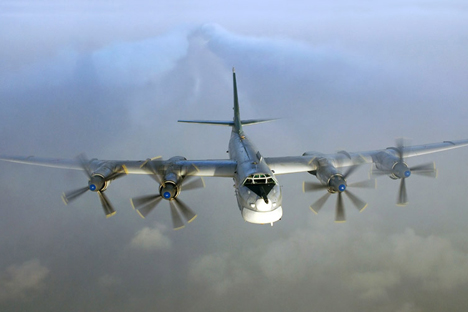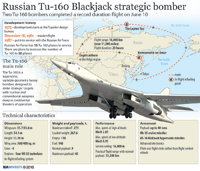Analysts divided on course of action for the Russian Air Force

It is noteworthy that Russia currently has about 200 long-range aircrafts, including 66 Tupolev Tu-95MS (photo) and 16 Tupolev Tu-160sSource: Press Photo
As the 100th anniversary of the Russian Air Force approaches us, an increasing number of celebrations are being planned. The most prominent Russian Military Analysts recently took part in a round table conference in Moscow devoted to the potential development of a new bomber for the Russian Air Force. However, while analysing the need for “aircraft of the future”, the specialists have differed in their views.
There was at least one thing on which all the participants of the round table, which was held in the Rosbalt Information Agency, have agreed upon: Russia should continue to maintain its existing fleet of strategic aircraft and continue to upgrade them. The resources allocated for the Tupolev Tu-95MS, Tu-160, and Tu-22М3 allow these aircrafts to remain in service for many years. In these conditions, the improvement of their equipment and weapons is one of the key tasks.
Such work is under way now: The Tupolev Tu-95MS and Tu-160 fighters are undergoing modernisation and the first upgraded Tu-22М3М has already been handed over to the military. Upgraded aircraft can use modern weapons, including non-nuclear precision-guided munitions, which makes them very useful in case of local conflicts. It is noteworthy that Russia currently has about 200 long-range aircrafts, including 66 Tupolev Tu-95MS and 16 Tupolev Tu-160s (the rest are Tupolev Tu-22М3s), and it is at the very least wasteful to leave all these heavy combat aircrafts without the possibility of carrying out non-nuclear tasks in local conflicts.
Despite the capabilities of the modernised Russian bombers, their resources are not infinite. They are to be replaced in 2030-2050 due to wear and tear. Meanwhile, taking into account a modern combat aircraft’s terms of development and serialised production, it is necessary to start development now in order to get a new aircraft by the beginning of the 2030s. However, some specialists do not support this point of view. During the round table, Deputy Director of the Centre for Analysis of Strategies and Technologies, Andrey Frolov was the main opponent of new strategic aircraft development.
“At this stage, maintaining the full-fledged nuclear triad is very burdensome for Russia. In this connection, developing a new long-range aircraft of the fifth generation may become one of the programs that does not make financial sense,” Frolov said..
Other participants of the discussion supported the development of new aircraft. “Russia needs fifth generation strategic bombers, first of all, in order to support its status of a nuclear power,” the National Defence magazine Editor-in-Chief Igor Korotchenko said.
According to the analyst, it is “the aviation component of the strategic nuclear forces that is most adaptable to the task of sending signals to opponents in critical moments, reminding them of the fact that the Russian armed forces are capable of solving any problems in case of a war.”
The head of the Institute of Political and Military Analysis Alexander Sharavin has also supported the new development: “I do not oppose the idea of upgrading old aircrafts. But what shall we do in 30 years? It is clear that such aircraft as the PAK DA project cannot be produced in three, five, or even ten years. Such tasks take many years to be fulfilled.”
The fate of PAK DA – the Prospective Air Complex for Long Range Aviation – is not clear yet. Arguments of all the participants contain a core of common sense. It seems that the general conclusion from all the above can be formulated as follows:
1. Today, maintaining the classic nuclear triad – long-range aviation, land-based missiles, and nuclear underwater missile carriers – is a topic for discussion.
2. Never the less, the development of a new long-range combat aircraft seems to be necessary. Given the length of Russian borders and the need to respond to potential threats, which may occur in different regions, Russia needs a unit of aircraft capable of readily hitting targets beyond the range of tactical aircraft without refuelling.
3. Until it comes to serial production of the new aircraft type, its development is not unduly wasteful, and it may be stopped, slowed down, and resumed at any point without special expenses.
4. Until convincing proof is received that new types of weapons – such as remotely piloted delivery systems and other aircrafts – can effectively replace the classic long-range bomber, this work should be continued. Development of an aircraft up to the moment of launching a series usually takes 10-15 years. It is a sufficient term for determining the prospects of the program.
All rights reserved by Rossiyskaya Gazeta.
Subscribe
to our newsletter!
Get the week's best stories straight to your inbox
